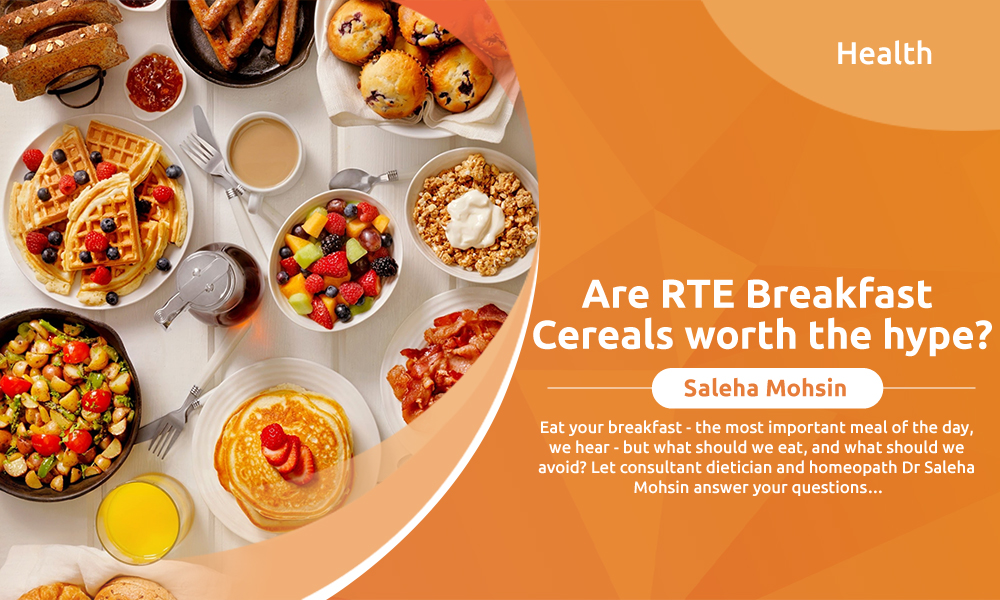Saleha Mohsin
Eat your breakfast – the most important meal of the day, we hear – but what should we eat, and what should we avoid? Let consultant dietician and homeopath Dr Saleha Mohsin answer your questions…
Breakfast is often referred to as an important meal of the day as it provides the necessary energy to kickstart the day. Including a healthy balance of protein, fruits, vegetables, grains, and dairy benefits in keeping nutritional deficiencies at bay. With our busy schedules and to ease our lifestyles, many of us turn to ready-to-eat (RTE) breakfast cereals as a quick and convenient option. But with so many cereal brands on the market, is it worth the hype? Let’s take a closer look at RTE breakfast cereals and examine whether they truly are breakfast essentials.
What are ready-to-eat (RTE) cereals?
RTE breakfast cereals are pre-packaged, ready-to-eat cereals that require no cooking or preparation. They are quick, convenient, come in a variety of flavours and types and may contain natural and added nutrients. These are made from cereals like rice, wheat, and oats which are processed, puffed, flaked, or shredded and coated with sugar, cocoa, and other frostings. A long list of RTE breakfast cereals is available in the market advertised as a healthy and convenient option to add extra nutrients to breakfast.
Convenience V/S Nutrition
Convenience and misleading marketing claims are the key attributes that pull customers to RTE cereals. Many of these RTE cereals are filled with refined grains, sugar, artificial flavours, colours, and other additives. Several RTE cereals provide about half of the daily recommended limit of sugar in one serving. They are rich sources of carbohydrates which can cause sugar levels to spike. Additionally, they are often ultra-processed. Ultra-processing has been linked with many health conditions like diabetes, hypertension, and heart disease. The sodium content is quite notifiable in some products. Even the content of vitamins and minerals like vitamin C, copper, and manganese is ‘high’ in some due to fortification. Reading the nutrition labels and ingredient list may help in making healthy choices. Due to its appealing taste and texture, it is easy to eat more than the specified serving size which may contribute to weight gain.
Making healthier choices
When it comes to choosing RTE breakfast cereals, it’s important to make informed choices. Here are a few points to consider:
Serving size: The nutrient content of the RTE cereals cannot be judged without considering the serving size. Many of them have a small serving size but provide adequate vitamins and minerals. Simple rule – the more calories dense the cereal is, the smaller the serving size. Often, portions consumed are far greater than the specified serving size.
Reading nutrition labels: Instead of falling for the nutrition claims, read the ingredients list. Advertisements like organic, natural, or containing fruits don’t mean that they’re healthy. Always look for the first 3-4 ingredients on the label to determine the major contents. Look for high-fibre and low sugar. According to the American Heart Association, the maximum limit of sugar for men and women is 9 teaspoons i.e., 36 gm and 6 teaspoons i.e., 24 gm respectively. The fibre content should be at least 3 gm and sugar not more than 5 gm per serving. Beware of these sneaky sugars like dextrose, corn syrup, cane sugar, malt syrup, inverted sugar syrup, and palm sugar. Note that many cereals give their nutrition label values after adding milk to them.
Adding healthy toppings: Add-ons like seeds (chia, flax, pumpkin, sunflower, sesame), nuts (almond, peanuts, walnuts) and fruits (berries, banana, apple) can increase the nutrient content. Adding yoghurt, cow milk, almond milk or soy milk will make it more enriching and fulfilling.
Selecting fortified cereals:
While selecting RTE cereals make sure to buy the ones fortified with vitamins and minerals for more nutritional benefits.
Ready-to-eat Cereals: Comparison
Choosing an unprocessed natural breakfast
It is best to choose wholesome natural foods for breakfast as they are satiety-promoting and keep you full for a long time. Here are a few great options:
Eggs with vegetables
Wholegrain porridge
Oatmeal with nuts
Fruits with yoghurt, seeds, and nuts
Pancakes with fruits and nuts
Fruit smoothies
While RTE breakfast cereals may be preferred by many customers as a healthy option, they are not a good choice for breakfast or snacks. Choosing other wholesome foods as alternatives can have a positive effect on nutrient consumption. It’s important to be aware of the marketing tactics used by cereal brands and to make informed choices when it comes to our breakfast options. With a little bit of preparation, we can enjoy a quick and healthy breakfast that provides us with the necessary fuel to start our day.



0 Comments